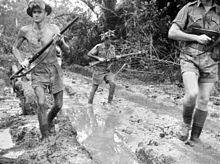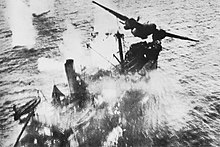South West Pacific theatre of World War II






The South West Pacific theatre, during World War II, was a major theatre of the war between the Allies and the Axis. It included the Philippines, the Dutch East Indies (except for Sumatra), Borneo, Australia and its mandate Territory of New Guinea (including the Bismarck Archipelago) and the western part of the Solomon Islands. This area was defined by the Allied powers' South West Pacific Area (SWPA) command.
In the South West Pacific theatre, Japanese forces fought primarily against the forces of the United States and Australia. New Zealand, the Netherlands (mainly the Dutch East Indies), the Philippines, United Kingdom, and other Allied nations also contributed forces.
The South Pacific became a major theatre of the war following the Japanese attack on Pearl Harbor in December 1941. Initially, US war plans called for a counteroffensive across the Central Pacific, but this was disrupted by the loss of battleships at Pearl Harbor. During the First South Pacific Campaign, US forces sought to establish a defensive perimeter against additional Japanese attacks. This was followed by the Second South Pacific Campaign, which began with the Battle of Guadalcanal.
Allied command[]
The U.S. General Douglas MacArthur had been in command of the American forces in the Philippines in what was to become the South West Pacific theatre, but was then part of a larger theatre that encompassed the South West Pacific, the Southeast Asian mainland (including Indochina and Malaya) and the North of Australia, under the short lived American-British-Dutch-Australian Command (ABDACOM). Shortly after the collapse of ABDACOM, supreme command of the South West Pacific theatre passed to MacArthur who was appointed Supreme Commander, South West Pacific Area on 30 March 1942.[1][2][a] However, MacArthur preferred to use the title "Commander-in-Chief." The other major theatre in the Pacific, Pacific Ocean Areas, was commanded by U.S. Admiral Chester Nimitz, who was also Commander-in-Chief Pacific Fleet. Both MacArthur and Nimitz were overseen by the US Joint Chiefs and the Western Allies Combined Chiefs of Staff.
Japanese command[]
This section does not cite any sources. (March 2020) |
Most Japanese forces in the theatre were part of the Southern Expeditionary Army (南方軍, Nanpo gun), which was formed on November 6, 1941, under General Hisaichi Terauchi (also known as Count Terauchi). The Nanpo gun was responsible for Imperial Japanese Army (IJA) ground and air units in Southeast Asia and the South Pacific. The Combined Fleet (聯合艦隊, Rengō Kantai) of the Imperial Japanese Navy (IJN) was responsible for all Japanese warships, naval aviation units and marine infantry units. As the Japanese military did not formally utilize joint/combined staff at the operational level, the command structures/geographical areas of operations of the Nanpo gun and Rengō Kantai overlapped each other and those of the Allies.
Major campaigns[]
- Battle of the Philippines (1941–1942)
- Battle of Bataan
- Battle of Corregidor
- Dutch East Indies campaign, 1941–1942
- Solomon Islands campaign, 1943–1945
- New Georgia Campaign, June–August 1943
- Battle of Kula Gulf, 6 July 1943[7]
- Battle of Kolombangara, 13 July 1943[7]
- Battle of Vella Gulf, 6–7 August 1943[7]
- Naval Battle of Vella Lavella, 6–7 October 1943[7]
- Battle of the Treasury Islands, 27 October-12 November 1943
- Battle of Empress Augusta Bay, 2 November 1943[7]
- Battle of Cape St. George, 25 November 1943[7]
- Bougainville Campaign, November 1943 – August 1945
- New Guinea campaign, 1942–1945
- Battle of Rabaul, January–February 1942
- Invasion of Salamaua–Lae, March 1942
- Battle of the Coral Sea, 4–8 May 1942[4]
- Invasion of Buna-Gona, July 1942
- Kokoda Track campaign, July–November 1942
- Battle of Milne Bay, August–September 1942
- Battle of Goodenough Island, October 1942
- Battle of Buna-Gona, November 1942 – January 1943
- Battle of Wau, January 1943
- Battle of the Bismarck Sea, 2 March 1943[4]
- Operation Chronicle, 1943
- Landing at Nassau Bay, 1943
- Salamaua-Lae campaign, April–September 1943
- Finisterre Range campaign, September 1943 – April 1944
- Huon Peninsula campaign, September 1943 – March 1944
- New Britain campaign, 26 December 1943[8]
- Admiralty Islands campaign, 29 February 1944[8]
- Invasion of Hollandia and landing at Aitape, 22 April 1944[9]
- Battle of Biak, 27 May 1944[9]
- Battle of Noemfoor, 2 July 1944[8]
- Battle of Morotai, 15 September 1944[9]
- Aitape-Wewak campaign, November 1944[8]
- Battle of Timor, 1942–1943
- Philippines campaign (1944–1945)
- Battle of Leyte, October–December 1944
- Battle of Leyte Gulf, 23–26 October 1944[9]
- Battle of Mindoro, December 1944
- Battle of Lingayen Gulf, January 1945
- Battle of Luzon, January–August 1945
- Battle of Manila, February–March 1945
- Battle of Corregidor, February 1945
- Invasion of Palawan, February–April 1945
- Battle of the Visayas, March–July 1945
- Battle of Mindanao, March–August 1945
- Battle of Maguindanao, January–September 1945
- Borneo campaign, 1945
- Battle of Tarakan, May–June 1945
- Battle of North Borneo, June–August 1945
- Battle of Balikpapan, July 1945
See also[]
Notes[]
- ^ Command of the South-East Asian theatre passed initially to British India Command and then in August 1943 to the joint Allied command known as South East Asia Command (SEAC).
- ^ Cressman 2000, p. 84.
- ^ Milner 1957, p. 22.
- ^ Dull 1978, p. 61.
- ^ Jump up to: a b c Silverstone 1968, pp. 9–11.
- ^ Dull 1978, p. 75.
- ^ Dull 1978, p. 91.
- ^ Jump up to: a b c d e f Potter & Nimitz 1960, p. 732.
- ^ Jump up to: a b c d Potter & Nimitz 1960, p. 759.
- ^ Jump up to: a b c d Sulzberger 1966, pp. 332–333.
References[]
- Cressman, Robert J. (2000). The Official Chronology of the U.S. Navy in World War II. Annapolis, Maryland: Naval Institute Press. ISBN 1-55750-149-1.
- Dull, Paul S. (1978). A Battle History of the Imperial Japanese Navy (1941–1945). Annapolis, Maryland: Naval Institute Press.
- Potter, E.B.; Nimitz, Chester W. (1960). Sea Power. Prentice-Hall.
- Silverstone, Paul H. (1968). U.S. Warships of World War II. Doubleday and Company.
- Sulzberger, C.L. (1966). The American Heritage Picture History of World War II. Crown Publishers.
Further reading[]
- Drea, Edward J. (1998). In the Service of the Emperor: Essays on the Imperial Japanese Army. Nebraska: University of Nebraska Press. ISBN 0-8032-1708-0.
- Eichelberger, Robert (1989). Our Jungle Road to Tokyo (reissue ed.). New York: Battery Press. ISBN 0-89839-132-6.
- Griffith, Thomas E. Jr. (1998). MacArthur's Airman : General George C. Kenney and the War in the Southwest Pacific. Lawrence, Kansas, U.S.A.: University Press of Kansas. ISBN 0-7006-0909-1.
- Krueger, Walter (1979). From Down Under to Nippon: Story of the 6th Army in World War II. Zenger. ISBN 0-89201-046-0.
- United States Army Center of Military History. "Japanese Operations in the Southwest Pacific Area, Volume II – Part I". Reports of General MacArthur. Retrieved 2006-12-08.- Translation of the official record by the Japanese Demobilization Bureaux detailing the Imperial Japanese Army and Navy's participation in the Southwest Pacific area of the Pacific War.
- South West Pacific theatre of World War II
- Pacific theatre of World War II
- Theaters and campaigns of World War II
- Military history of Australia during World War II
- Military history of New Zealand during World War II
- Military history of the Philippines during World War II